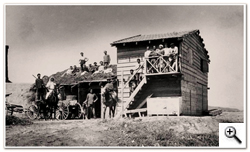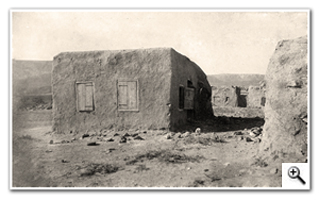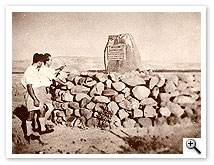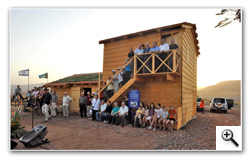|
In the fifth century B.C. Rabbi Tanhum Bar-Hiya, whose name is mentioned in the Jerusalem Talmud, the Babylonian Talmud and the Midrash texts, resided in the village of Agin (Agon, Gon) which later became the tiny Arab village of Umm Juni (Umm Junia). Umm Juni belonged to the Persian effendi family Majid a-Din, whose land was by serfs and Arab day laborers. About twenty families inhabited the village, built on the western edge of the plain; from this edge a steep slope descended into the ravine in which the Jordan River flows. Another village, Abudiya, was located two kilometers south of Umm Juni.
In 1905 the lands of Deleika and Umm Juni were purchased by the IKA official Haim Margaliyot Klavorski. There were no Jewish settlers there at the time so the Arab villagers of Umm Juni continued to till the lands.
In 1907 the Keren Kayemet fund purchased some of the Deleika land and all of the Umm Juni tract east of the Jordan River from the J.C.A. (Jewish Colonization Organization). This was one of the first actions taken by the Keren Kayemet in the Land of Israel.
In 1908 Dr. Arthur Ruppin, head of the Zionist Federation's Land of Israel Office, established the farm at the Khan on the Moshava Kinneret to serve as a facility for the training of agricultural workers, which came to be known as the Kinneret Yard. In the fall of that year, workers from the farm were sent to plough the Umm Juni lands in order to conquer it through Jewish labor and keep it from being returned to the Turkish authorities, according to the law at that time. These workers lived at Umm Juni, ploughing during the week and returning to the Yard for the Sabbath.
Disputes which broke out between the farm manager and the workers resulted in a strike on the farm. In the wake of these events, Arthur Ruppin realized an idea formulated by the workers "to give a group of trained workers a large tract of land for them to farm and manage independently." For this he allocated the land of Umm Juni, about 5,500 dunams. It was thus that the conquest group was formed, comprising eight men and one woman from among the senior Galilee workers, as ed by the various parties. The group tilled the Umm Juni land throughout the year 1910, which was a 'blessed' year, ending with a big harvest. Thus the workers proved that self-management was feasible and economically viable. The group members lived in huts of the Arab village and in a shack brought by train from Haifa, assembled and erected alongside the village dwellings. This shack was to become a symbol of Degania.
|

|
|
The shack at Umm-j'uni |
At the end of 1910, after the "conquest group" was disbanded, Arthur Ruppin invited the "Hadera Commune" to come and take their place; after due deliberation the commune members gave their consent and came to settle at Umm Juni.
This is what the pioneers wrote:
“On the 28th of October 1910, there arrived at Umm Juni ten men and two women. "We came to establish an independent settlement of Hebrew laborers, on national land, a collective settlement with neither exploiters nor exploited – a commune”.
The "Umm Juni act" was not publicized at first so as not to cause disappointment in the event of failure as well as to avoid opposition on the part of some of the Zionist Federation leadership. As it succeeded it became famous throughout the land, stimulating the labor movements and receiving widespread recognition and renown in the Diaspora.
|

|

|
|
The contract |
The mud hut in Umm-Juni used as office |
The commune members remained at Umm Juni, working hard to consolidate the farm. It was here that the work procedures and organizational methods were formed; here began the kibbutz way of life in which the women struggled for their rightful place at work and in society, with a demand for equal and full rights and obligations.
The group created good neighborly relations with the Arabs of Zemach and Abudiya, however violent clashes did take place with the nomadic Beduin tribes which raided the valley from time to time.
Ties with the laborer groups active in the country were maintained and strengthened.
At Umm Juni the group members made the decision to call their settlement "Degania", and sent the following telegram letter to Dr. Arthur Ruppin:
“To the director of the Land of Israel Office, Dr. Arthur Ruppin,
Dear Sir,
"We hereby inform your honor that we have named our new settlement ‘Degania’, after the five varieties of grains growing here" (wheat, barley, oats, corn and sorghum).
After the success of the first year, the Land of Israel Office decided to build a permanent site at the exit of the Jordan River from Lake Kinneret. At the site a courtyard was built, surrounded by additional buildings. After a year and a half spent at Umm Juni, on the Holiday of Shavu'ot 5673 (1912), the group moved to a permanent site.
In 1926 the first settlers of Kibbutz Beit Zera settled in the huts of Umm Juni, since by this year no more Arabs were no longer living there. In 1927 an earthquake destroyed all of the village's clay dwellings; the Beit Zera settlers were left homeless until moving to the present-day permanent site of their kibbutz.
In 1940 on Degania's 30th anniversary, its members and children erected a large monument made of stones at Umm Juni, in commemoration of those heady early days and to keep the place alive in memory and each year on Degania's anniversary. The members and children would add another layer of stones to the monument. A sign was placed on the pile of stones which read:
Umm Junia
[the village of Gon, Agin]
At this place stood a clay hut
In which lived in the year of 1911
The pioneers of Kibbutz Degania
In 1960, on Degania's Jubilee, a stone wall was erected at Umm Juni on which the names of all the kibbutzim were engraved in order respectively of the dates of their establishment. In 1980 the site was renovated for Degania's 70th anniversary.
|

|

|
|
The monument in Umm-Juni 2012 |
The monument in Umm-juni 1945 |
In 2010, the Centennial, Degania, the "Keren Kayemet" (JNF) and "The Council for The Preservation of Historical Buildings in Israel" combined forces in the design and construction of a replica of the Umm Juni shack and the development of an infrastructure for receiving visitors at the site. The site will include an observation post facing the western Jordan Valley and a promenade along the Jordan cliff, as well as a shaded sitting area and drinking water fountain for the benefit of hikers and visitors
|

|
|
The new Umm-j'uni shack 2011 |
|

